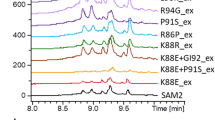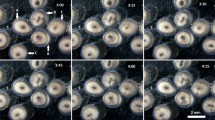Summary
We have studied the regulation of two cysteine biosynthetic enzymes in S. typhimurium merodiploid strains which are heterozygous at the cysB regulatory locus. This gene codes for an element of positive control which is necessary for the expression of the enzymes of the biosynthetic pathway. Under conditions of sulfur deprivation levels of sulfite reductase (coded for by cysI, cysJ and cysG) and of O-acetylserine sulfhydrylase (coded for by cysK) are derepressed in cysB + haploid strains, but not in cysB - haploid strains. Growth on a rich sulfur source such as l-cystine results in low levels of both enzyme activities in cysB + and cysB - haploid strains but not in cysB c haploid strains, where enzyme expression is constitutive, i.e. substantially greater than in a cysB + strain grown on l-cystine, regardless of the nutrients used for growth.
We find that cysB -/F cysB + merodiploid strains can be derepressed for sulfite reductase and O-acetylserine sulfhydrylase by growth on a poor sulfur source, and therefore cysB + is dominant to cysB -. Enzyme levels are also derepressed in l-cystine-grown cysB c/F cysB + strains indicating that cysB c is dominant to cysB +. The cysB484 allele is known to be cysB - in regard to the regulation of sulfite reductase activity, but cysB c with respect to O-acetylserine sulfhydrylase. In a cysB484/F cysB + strain the cysB - character of cysB484 is recessive to cysB +, while cysB c is dominant to cysB +.
Merodiploids of the type cysB -/F cysB +, bearing chromosomal point mutations are derepressed by sulfur deprivation to levels which are either less than, equal to, or greater than those of wild type. These results can be explained by assuming a multimeric structure for the cysB protein and the formation in merodiploids of cysB -/cysB + hybrid molecules with altered capacities for gene activation. The dominance of cysB c over cysB + indicates that in contrast to the araC regulatory protein, which acts as both a gene activator and repressor, the cysB protein serves only as an element of positive control.
Similar content being viewed by others
References
Baptist, E.W., Kredich, N.M.: Regulation of L-cystine transport in Salmonella typhimurium. J. Bact. 131, 111–118 (1977)
Becker, M.A., Kredich, N.M., Tomkins, G.M.: The purification and characterization of O-acetylserine sulfhydrylase-A from Salmonella typhimurium. J. biol. Chem. 244, 2418–2427 (1969)
Borum, P.R., Monty, K.J.: Regulatory mutants and control of cysteine biosynthetic enzymes in Salmonella typhimurium. J. Bact. 125, 94–101 (1976)
Cheney, R.W., Kredich, N.M.: Fine-structure genetic map of the cysB locus in Salmonella typhimurium. J. Bact. 124, 1273–1281 (1975)
Gornall, A.G., Bardawill, C.J., David, M.M.: Determination of serum proteins by means of the biuret reaction. J. biol. Chem. 177, 751–766 (1949)
Hulanicka, D., Klopotowski, T.: Mutants of Salmonella typhimurium resistant to triazole. Acta biochim. pol. 19, 251–260 (1972)
Jones-Mortimer, M.C.: Positive control of sulphate reduction in Escherichia coli. Biochem. J. 110, 597–602 (1968)
Jones-Mortimer, M.C., Wheldrake, J.F., Pasternak, C.A.: The control of sulphate reduction in Escherichia coli by O-acetyl-L-serine. Biochem. J. 107, 51–53 (1968)
Kredich, N.M.: Regulation of L-cysteine biosynthesis in Salmonella typhimurium. J. biol. Chem. 246, 3474–3484 (1971)
Sakami, W., Toennies, G.: The investigation of amino acid reactions by methods of non-aqueous titrimetry. J. biol. Chem. 144, 203–217 (1942)
Sheppard, D., Englesberg, E.: Positive control in the L-arabinose gene-enzyme complex of Escherichia coli B/r as exhibited with stable merodiploids. Cold Spr. Harb. Symp. quant. Biol. 31, 345–347 (1966)
Sledziewska, E., Hulanicka, D.: Method of isolation of cysteine constitutive mutants of the cysteine regulon of Salmonella typhimurium. FEBS Proc. Meet. Abstract. 260 (1977)
Smith, D.A.: S-Amino acid metabolism and its regulation in Escherichia coli and Salmonella typhimurium. Advanc. Genet. 16, 141–165 (1971)
Smith, H.O., Levine, M.: A phage P22 gene controlling integration of prophage. Virology 31, 207–216 (1967)
Somerville, R.L., Yanofsky, C.: Studies on the regulation of tryptophan biosynthesis in Escherichia coli. J. molec. Biol. 11, 747–759 (1965)
Spencer, H.T., Collins, J., Monty, K.J.: Sequential regulation of cysteine biosynthesis in Salmonella typhimurium. Fed. Proc. 26, 677 (1967)
Tully, M.D., Yudkin, M.D.: The nature of the product of the cysB gene of Escherichia coli. Molec. gen. Genet. 136, 181–183 (1975)
Vito, P.C. de, Dreyfuss, J.: Metabolic regulation of adenosinotriphosphate sulfurylase in yeast. J. Bact. 88, 1341–1348 (1964)
Vogel, H.J., Bonner, D.M.: Acetylorinithinase of Escherichia coli. J. biol. Chem. 218, 97–106 (1956)
Author information
Authors and Affiliations
Additional information
Communicated by G. O'Donovan
Rights and permissions
About this article
Cite this article
Jagura, G., Hulanicka, D. & Kredich, N.M. Analysis of merodiploids of the cysB region in Salmonella typhimurium . Molec. Gen. Genet. 165, 31–38 (1978). https://doi.org/10.1007/BF00270373
Received:
Issue Date:
DOI: https://doi.org/10.1007/BF00270373




